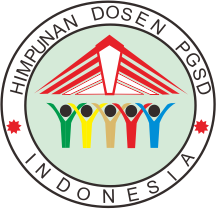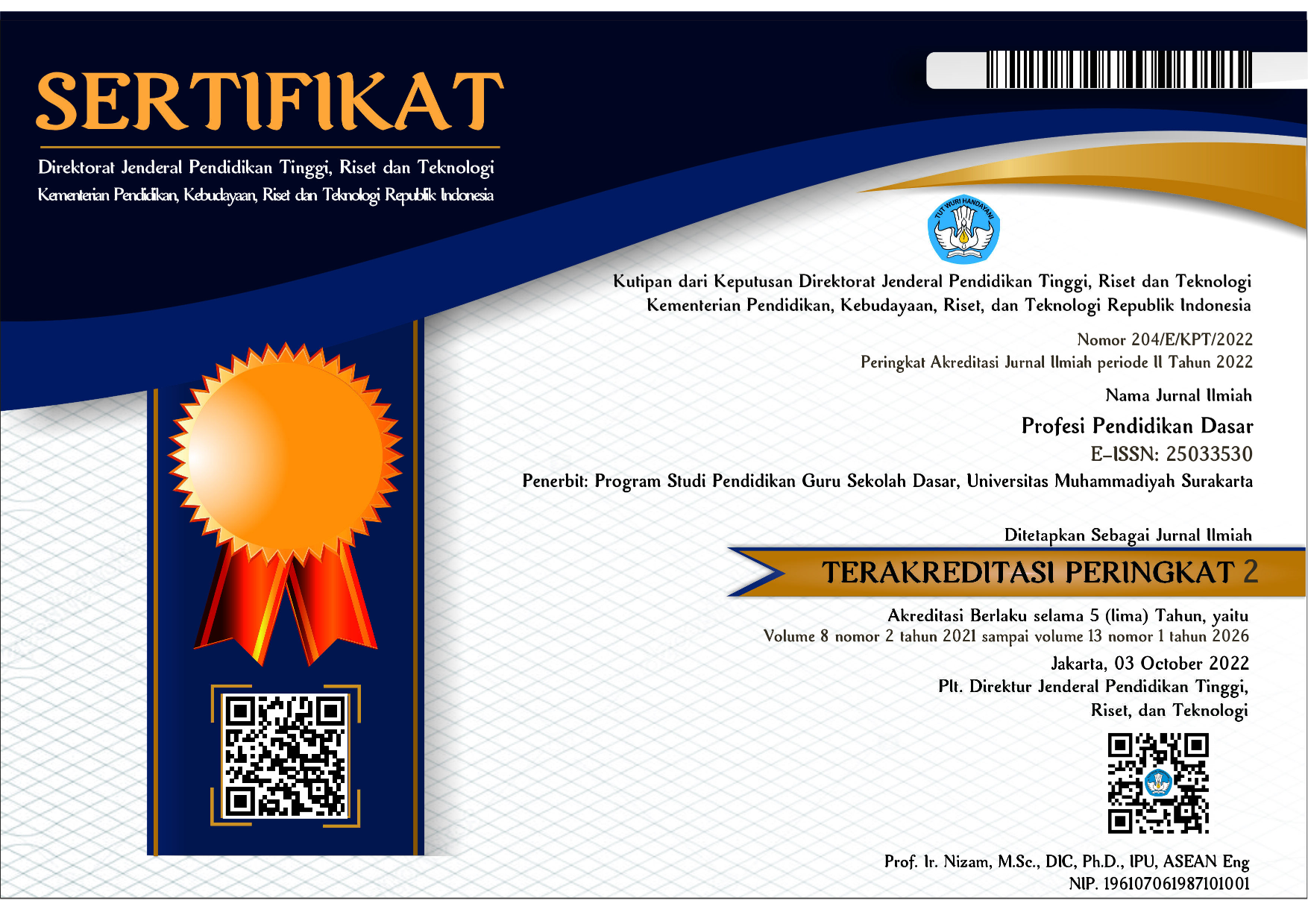The Validation of LIAA (Linguistic Intelligence Assessment Android) Development In Elementary School
Otang Kurniaman(1*), Muhammad Luthfi Hidayat(2), Eddy Noviana(3), Munjiatun Munjiatun(4), Kurniawan Kurniawan(5)(1) Universitas Riau
(2) King Abdulaziz University, Jeddah
(3) Universitas Riau
(4) Universitas Riau
(5) Universitas Riau
(*) Corresponding Author
Abstract
This study provides an overview of the validation results of teachers and media experts to assess the LIAA (Linguistic Intelligence Assessment Android) application, using the research and development method. This method is used to develop a product and tests its effectiveness. However, this article is just for developing and designing LIAA. The results of the study showed response proportion: 78% for the teacher's language use, 84% for ease of application, 75% for final clarity of assessment, 84% for the presentation, 72% for the average of the final assessment test. Validation from media experts to assess the appropriateness of using the LIAA application with an average of 88% (very valid category). So it is concluded that the LIAA application can be applied on a wide scale in measuring the linguistic intelligence of elementary school students.
Keywords
Full Text:
PDFReferences
Andro, J. (2020). Analysis Of Linguistics Intelligence On Students At Class V SD Negeri 169 Pekanbaru. Jurnal PAJAR (Pendidikan dan Pengajaran), 4(3), 536-543. DOI : http://dx.doi.org/10.33578/pjr.v4i2.7973.
Aminatun, D., Ngadiso., & Marmanto, S. (2018). Applying PLEASE Strategy to Teach Writing Skill to Students with Different Linguistic Intelligences. TEKNOSASTIK, 16 (1), 34-40.
Armstrong, T. ( 2002 ). 7 Kinds Of Smart (Menemukan Dan Meningkatkan Kecerdasan Anda Berdasarkan Teori Multiple Intelligence). Jakarta: Gramedia Pustaka Utama
Bakri, M. A. (2018). Studi Awal Implementasi Internet Of Things Pada Bidang Pendidikan. Journal of Electrical and Electronics, 4 (01), 18-23.
Becker, K. A. (2003). History of the Stanford- Binet intelligence scales: Content and psychometrics. IL: Riverside Publishing.
Chase, D. (2005). Underlying factor structures of the Stanford-Binet intelligence scales – 5th Ed. (Doctoral dissertation, Drexel University, USA).
Campbell. L and Campbell, B. (1999). Multiple Intelligence and Student AchievementSuccess Stories From Six Schools. USA.ASCD.
Ellis, R. (2008). The study of second language acquisition (2th ed.). Oxford: Oxford University Press.
Fraenkel, J. R., and Wallen, N. E. (2007). How to Design and Evaluate Research in Education. Sixth Edition. Singapore: McGraw – Hill International Edition.
Hajhashemi, K., Ghombavani, F. & Amirkhiz, S. (2011). The Relationship between Iranian EFL High School Students' Multiple Intelligence Scores and their Use of Learning Strategies. English Language Teaching, 4(3), pp. 214–22.
Hassaskhah, J. (2009). There is never any one right way to teach! A case of multiple intelligence. Iranian EFL Journal, 4, 110-133.
Islam, P. S. (2019). Perkembangan Teknologi dan Pengaruhnya terhadap Penggunanya. [Online] 16 Mei 2020. https://www.kompasiana.com/putrisuryaislam/5dd2ca75097f36260936d522/perkembangan-teknologi-dan-pengaruhnya-terhadap-penggunanya.
Kurniaman, O., Noviana, E., Pratiwi, S. A., Maharani, D. S., Afendi, N. (2020). The Effect Of Smartphone On Student Emotions. International Journal Of Scientific & Technology Research, 9 (01), 138-141.
Karmiani, S. (2018). Penggunaan Media Komik Berbahasa Inggris Sebagai Upaya Meningkatkan Kemampuan Membaca Pemahaman Bahasa Inggris Pada Siswa Kelas VIII SMPN 3 Teluk Kuantan. Jurnal Pajar (Pendidikan dan Pengajaran), 2 (6), 883- 890. DOI: http://dx.doi.org/10.33578/pjr.v2i6.6514.
Kurniaman, O., Maharani, D. S., Noviana, E., Afendi, N. (2020). Development of Linguistic Intelligence Instruments for Elementary Schools Student. ELS Journal on Interdisciplinary Studies on Humanities, 3 (1), 85-96.
Kurniaman, O., Noviana, O., Pratiwi, S. A., Maharani, D. S., & Afendi, N. (2020). The Effect Of Smartphone On Student Emotions. International Journal Of Scientific & Technology Research , 9 (01), 138-141.
Kurniaman, O., Noviana, E., Munjiatun, M., Zufriady, Z., & Kurniawan, K. (2020). Analysis of Teacher Perceptions in the Development of LIAA (Linguistic Intelligence Assessment Android) in Elementary Schools. International Journal of Latest Research in Humanities and Social Science (IJLRHSS), 3(11), 1-5.
Lazear, D. (1999). Eightn ways of teaching: The artistry of teaching with multiple intelligences. Palatine, IL: IRI Skylight Publishing Inc.
Maharani, D. S., dkk. (2019). Development of Instruments for Assessing Linguistic Intelligence in Elementary Schools. Journal of Teaching and Learning in Elementary Education (JTLEE), 2 (2), 136- 144.
Mcbride, B. B., Brewer, C. A., Berkowitz, A. R., & Borrie, W.T. (2013). Environmental literacy, ecological literacy, ecoliteracy: What do we mean and how did we get here?. SYNTHESIS & INTEGRATION, 4(5), 1-20.
Mubasyira, M. (2014). The Effect Of Linguistic Intelligence Toward English Achievement At SMA Tugu Ibu, Depok. Faktor Jurnal Ilmiah Kependidikan, 1 (2). 215-228.
Noviana, E., Kurniaman, O., & Huda, M. N. (2018). Pengembangan Aplikasi Bimbingan Tugas Akhir Mahasiswa Berbasis Website Pada Program Studi Pendidikan Guru Sekolah Dasar FKIP Universitas Riau. Primary: Jurnal Pendidikan Guru Sekolah Dasar, 7(1), 1-12.
Nima, S. (2007). On the relationship between linguistic intelligence and recalling lexical items in SLA. International Journal of Research Studies in Education, 6(4), 29-36.
Pradana, ABA. (2018). Pembelajaran Bahasa Inggris Berbasis Multiple Intelligence pada Tipe Kecerdasan Linguistik. Didaktika Tauhidi: Jurnal Pendidikan Guru Sekolah Dasar, 5(1): 41-52.
Septyanti, E., Kurniaman, O., & Charlina, C. (2020). Development Of Interactive Media Based On Adobe Flash In Listening Learning For University Student. International Journal Of Scientific & Technology Research, 9 (01), 74- 77.
Subekti, H., dkk. (2018). Mengembangkan Literasi Informasi Melalui Belajar Berbasis Kehidupan Terintegrasi STEM Untuk Menyiapkan Calon Guru Sains Dalam Menghadapi Era Revolusi Industri 4.0: Revieu Literatur. Education and Human Development Journal, 3 (01), 81-90.
Sugiyono. (2015). Metode Penelitian Pendidikan. Bandung: Alfabeta.
Saeidi, M., & Mazoochi, N. (2013). A Comparative Study on Bilingual and Monolingual Iranian EFL Learners' Linguistic Intelligence across Genders. Life Science Journal, 10(6s), 321-334. http://www.lifesciencesite.com.
Sugiyono. (2017). Cara Mudah Menyusun Skripsi, Tesis, dan Disertasi. Bandung: Alfabeta.
Sumarta. (2016). The Effects Of Linguistic Intelligence And Interpersonal Communication Competence Toward Students' English Speaking Skill. Judika (Jurnal Pendidikan Unsika), 4(2). 157-168. http://journal.unsika.ac.id/index.php/judika.
Tirri, K. & Nokelainen, P. (2012). Measuring Multiple Intelligences and Moral Sensitivities in Education. Basic Books, New York.
Timmins, B. A. (1996). Multiple Intelligences: Gardner's Theory. Practical Assessment, Research, and Evaluation, 5(10), 1-3. DOI: https://doi.org/10.7275/7251-ea02
Article Metrics
Abstract view(s): 810 time(s)PDF: 627 time(s)
Refbacks
- There are currently no refbacks.


















